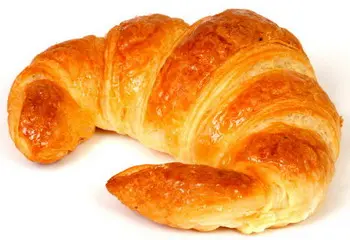The blog of cooking-ez.com
The beautiful story of the croissants

As you may have already noticed, cooking, baking and pastry-making are full of stories or legends, usually very romantic, about this or that product or recipe. This is often the case for named recipes, for example tarte tatin, peach melba, paris-brest and many others, but it also applies to very emblematic products of the bakery.
Well, here is the beautiful story of the "invention" of croissants.
Well, here is the beautiful story of the "invention" of croissants.
13K 19 5
Last modified on: October 10th 2018
Keywords for this post:BakeryBakersMineViennoiserieVienneCroissantHistoryAustriansTurksMarie-antoinetteThe beautiful story of the croissants

July 14, 1683, the Turks (at the time they were called "Ottomans") laid siege to Vienna for the second time. The city was, at the time, still fortified, and although it was the dawn of the Enlightenment, it was still a quasi-feudal attack that was being prepared: the Turks surrounded the city and cut off its supplies, thus hoping for a more or less rapid surrender of the Viennese.
It is a long siege war, but at the time already "mine" that is to say that the attackers not content with firing on the walls with cannons, dig galleries from their lines to the fortifications, and once arrived below fill with black powder and explode, hoping to create a breach in the walls and allow a rapid invasion.
The defenders are not idle, they dig galleries in the other direction, counter-mines, to try to eliminate the miners. To do this, they were listening, trying to detect the pickaxes of the Turkish miners' progression. Cleverly, the Turks decided to dig only at night, counting on the sleep of the Viennese to advance discreetly.
Bad luck for them, at night the bakers were at work, and in their bakeries they heard the miners digging, warned the authorities, who reacted to thwart the attack. The Viennese bakers saved the city from the Turk! (At least, that's the legend).
To celebrate this event, the bakers threw a small loaf of bread (probably brioche) in the shape of the crescent found on the Ottoman flag, this cake is called "hörnchen" ("little horn").

This same bun was brought to France with the arrival of the Arch-Duchess Marie-Antoinette, future wife of Louis XVI and Queen of France. Over time, and especially at the beginning of the 20th century, the original bun, under the influence of the French bakers, Parisian in particular, became something more sophisticated, both leavened and flaky, it is the croissant that we know today, of which only the original shape remains.

Nice story, isn't it?
That's also why we talk about viennoiseries, in France only, to group together everything that concerns leavened dough(brioche dough, bread pudding, brioche bread, etc.) and leavened leafy dough (croissant, pain au chocolat, raisin bread, etc.).
Note: You will often read or hear "The world, or the future, belongs to those who get up early", this is completely false, because if it were true the bakers would have been the masters of the world for a long time!
Lasts posts
Wipe meats and fish before cooking
When you want to cook meat or fish, there's a very simple yet very important step to take before you even start: It's to dry, or wipe, each side of the meat or fish, sometimes called "dabbing" or "sponging". But why? And how? Let me explain.1,5185 April 14th 2024
Toss the salad
When you've finished preparing a salad, green or otherwise, it's usually time to add the dressing and toss. It's often said to "toss the salad", which means to season and mix. Is it easy? Not so easy...2,8565 March 8th 2024
Half milk, half cream
In a multitude of recipes, savoury or sweet, milk is used as the main ingredient, or at least as the main liquid ingredient. Milk is used instead of water, for example, because milk contains a proportion of fat, which adds roundness and softness to the recipe. This mellowness is very pleasant on...2,694 February 27th 2024
Cutting soft cheeses
As you may have already noticed, when you have to use a "soft" cheese in a recipe - their exact name is "soft cheese" - such as Camembert, Munster or Mont d'or, it's not easy to make anything other than thick slices.2,8155 February 20th 2024
It's spinning too fast!
When you need to grate or slice vegetables, you generally use an electric machine that does all the work: a food processor, a mixer with a "slicer" extension or similar. Are these machines really suitable? Generally speaking, yes of course, but there's one criterion that often poses a problem,...5,7805 November 12th 2023
Other pages you may also like
Candied fruits: don't get ripped off
Do you like candied fruit? You might like to nibble a handful or add it to a recipe, like a classic fruit cake or delicious Italian specialities like panettone or sicilian epiphany pie.53K 24.2 June 21th 2017
Perpetual stock
It's something you have probably have done yourself: cooked or pre-cooked vegetables before adding them to a recipe. This is almost always done the same way: peel the chosen vegetables (carrots, for example), cut them up, boil them in salted water (using a tablespoon or so of coarse salt per litre),...23K5 November 22th 2016
What is the difference between bakery and patisserie?
This is a question that you may well have asked yourself and which I will attempt to answer. In France the two trades of "boulangerie" (bakery) and "pâtisserie" (patisserie and confectionery) have always been quite distinct, but where exactly do the boundaries lie? .119K 14.1 February 7th 2017
The "pith" of the cauliflower
When using cauliflower in a recipe, there is a lot of preparation work at the beginning: removing the leaves, taking the tops or florets, etc. It's a bit tedious, but in the end you're left with the best of the cauliflower, ready to be used in your recipe.8,3284.9 February 5th 2022
The French baguette and UNESCO
As you may have already read here or there, France has initiated for some time the procedure to try to have the French baguette classified as an intangible world heritage by UNESCO. When you put it like that, it sounds a bit namby-pamby, and it would be tempting to imagine an American (for...10K4.9 March 18th 2020
Follow this page
If you are interested in this page, you can "follow" it, by entering your email address here. You will then receive a notification immediately each time the page is modified or a new comment is added. Please note that you will need to confirm this following.
Note: We'll never share your e-mail address with anyone else.
Alternatively: you can subscribe to the mailing list of cooling-ez.com , you will receive a e-mail for each new recipe published on the site.









